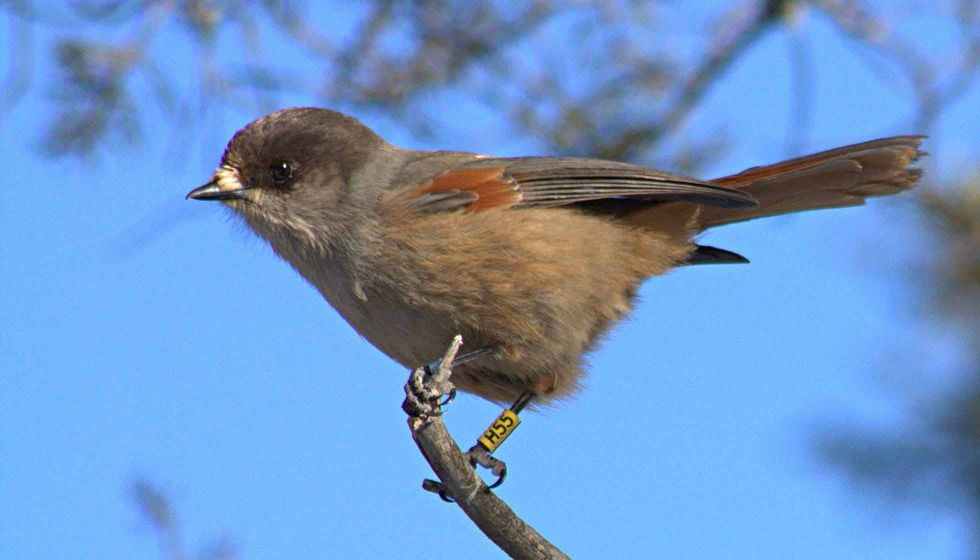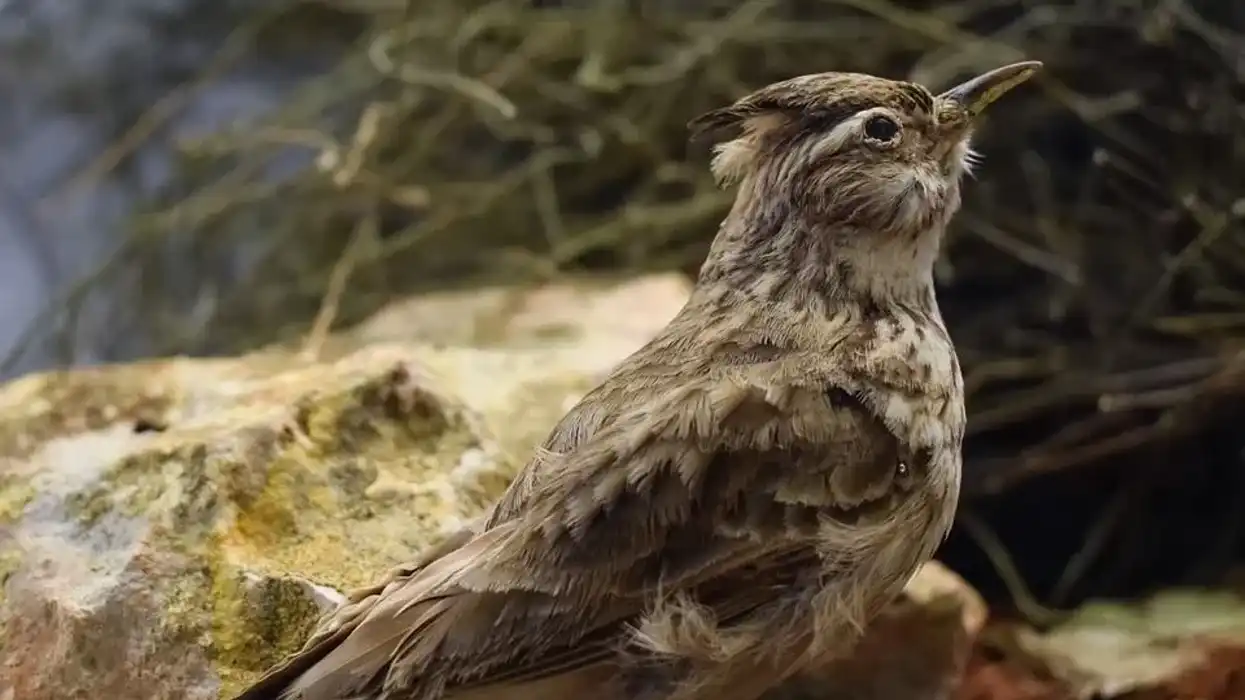The Siberian jay (Perisoreus infaustus) is found in a large range in North Eurasia. It is a small species of jay with a gray-brown plumage and a dark brown head.
The species was earlier called a soul bird as souls were earlier considered to move inside these birds. This group of jays are usually sedentary and do not move much from their habitats.
Due to its large distribution, the Siberian jay is considered abundant and is not in danger currently. However, in southern Finland, the population of the species is decreasing alarmingly and is considered Near Threatened.
Jays fall in the family of Corvids and all of the members in this family have almost similar physical appearances. However, the Siberian jay size is similar to a mistle thrush. It is also among the passerine birds but falls under a different family.
For more relatable content, check out our facts about the great green macaw and the night parrot.
Siberian Jay Interesting Facts
What type of animal is a Siberian jay?
Siberian jays are a species of jay in the family of Corvidae. The family Corvidae consists of members like crows, ravens, rooks, jays, nutcrackers, jackdaws, and magpies. This group is commonly known as the crow family or corvids.
What class of animal does a Siberian jay belong to?
The Siberian jay belongs to the class of Aves in the kingdom of Animalia.
How many Siberian jays are there in the world?
The range of distribution of the Siberian jay (Perisoreus infaustus) is spread across an area of 3861022 mi² (10,000,000 km²). It is estimated that the population of the bird species is around 680,000-1,400,000 in Europe itself. Their population is estimated to be around 4-8 million worldwide. Between 40000-80000 pairs of this species is found breeding in Finland.
Where does a Siberian jay live?
The distribution of the Siberian jay ranges from Scandinavia to northern Russia and Siberia. The bird species are seen in Norway, Mongolia, Finland, Sweden, Russia, China, and Kazakhstan. The Siberian jay is also seen sometimes in Poland, Slovakia, Ukraine, Belarus, Latvia, and Estonia. The species is sedentary and often does not move.
What is a Siberian jay's habitat?
The habitat of the Siberian jay includes dense forests within lowlands and foothills. It is usually in a closed canopy. The nest is made in the tree of the spruce forest where the species is also known to forage.
Dense forests help the species to conceal themself. The bird is very selective of its habitat needed for breeding and foraging. The Siberian jay is mostly seen inside the dense forests rather than open field areas.
There is not much information on the Siberian jay migration pattern. Although, some birds found in the east of the range and travels southwards during the winter season.
Who do Siberian jays live with?
The social lives of the Siberian jays are pretty complex as they live in small flocks of two to seven individuals. The males and the breeding pairs are dominant in the group.
These birds are aggressive towards intruders who are usually chased away. The most intriguing fact about these birds is that a pair takes in chicks of other pairs too when needed. This is quite different from other species of birds living in the world.
How long does a Siberian jay live?
On average, the Siberian jay lives for around seven years. The longest recorded Siberian jay life span was however 13 years and was seen in Finland.
How do they reproduce?
Pairs stay together and breed for life. An individual only searches for a new mate in the event of the demise of a partner. They are very territorial and guard their territories against intruders.
Sometimes, they even search for other sites if the breeding success rate seems to be higher. The nest is made in a spruce tree or in a pine in the month of March and takes about three weeks. The female builds the nest while both partners search for the nest materials.
A clutch of one to five eggs is laid in late March and are colored blue, pale green, or gray. They also have spots of brown or gray. The females incubate the eggs for 19 days and the males provide food for the mothers and the chicks.
The chicks born in the previous year help the Siberian jay pair to make the nest. They may also adopt other chicks in the forests which is quite rare among birds.
What is their conservation status?
The Siberian jay (Perisoreus infaustus) is evaluated as Least Concern by the IUCN Red List. The Siberian jay distribution is over a large range of habitats and is quite populous in those areas. There is no immediate threat to the population of the bird species, however, it is decreasing at a slower rate.
Siberian Jay Fun Facts
What do Siberian jays look like?
The Siberian jay (Perisoreus infaustus) has a grsy-brown coloration in its body. The bird has a dark brown crown on the head and a paler neck. It has a rust-colored marking on the rump, edge of the tail, and the leading edges of wings.
The bird has a buff breast. A graying chin and throat are seen too. The bill and legs are colored black and the rump is yellow.
The plumage is soft and fluffy which helps the bird from extreme weather. The colors in the body help them hide well within the forest.
Both male and female species look the same. The juvenile has a paler head. The chick, otherwise, looks similar to the adult species of the bird.
How cute are they?
Jays are considered quite cute with their small size and beautiful plumage.
How do they communicate?
This bird is known to be mostly silent all the time. The song of this bird during the breeding season has a lot of different sounds and is heard over a short distance. When in the proximity of predators, the bird is known to utter a loud scream to scare away everything near.
How big is a Siberian jay?
The length of the Siberian jay range from 10.23-11.41 in (26–29 cm). The length of the blue jay, one of the most common jay species mainly found in North America, is quite similar in length to the Siberian jays. A blue jay has a range of 9-12 in (23-30 cm).
How fast can a Siberian jay fly?
The speed is not known. However, they are pretty quick and dive a lot from trees when in danger. They are known to attack humans as well – if they feel threatened.
How much does a Siberian jay weigh?
The weight of the species ranges from 0.16-0.19 lb (75-90 g).
What are the male and female names of the species?
The males and females of the Siberian jay (Perisoreus infaustus) are not given different names.
What would you call a baby Siberian jay?
A baby Siberian jay is called a chick.
What do they eat?
This group of birds is omnivorous and is seen feeding mostly on berries, seeds, insects, and spiders. The bird also has eggs of small birds, snails, slugs, small mammals, and lizards as food.
This bird species is a hoarder and is known as scatter hoarders as they usually distribute their food over a large area. Berries are collected and distribution is done behind the loose bark of the tree in the forest. The bird is also seen feeding on big carcasses killed by predators like wolverines and wolves.
This species is mainly predated by sparrowhawks and goshawks for food. The eggs and the young of the Siberian jay are also used as food by squirrels, ravens, and hooded crows. This is the reason the birds make the nest in dense foliage.
The birds are usually seen feeding in closed forest areas to avoid detection by predators. They occasionally come out to open areas to forage for insects. In the winter season, the bird is seen feeding and collecting small rodents in open areas.
Are they dangerous?
They are not at all dangerous.
Would they make a good pet?
Siberian jays are usually not considered pets. They like to remain inconspicuous in the forest and thrive in those habitats. However, they are quite hardy and form a good relationship with humans. They are fearless in humans' company.
Did you know...
The Siberian jay (P. infaustus) has five recognized species. All of them are differentiated according to their distribution in the world.
Cup-shaped nests are made in a coniferous tree at a height of 79-394 in (2–10 m).
How many types of jays are there?
There are around 35-40 species of jays known to date. Most are found in the New World, however, some like the Siberian jay are found in Eurasia. All jays are known for their bold and loud screams. Jays are a part of the crows family of Corvidae.
How is Siberian jay different from regular jay?
The Siberian jay (Perisoreus infaustus) is one of the species of jays found in Eurasia. Jays are shy and are confined to their habitats of woodlands. Apart from the coloration in their bodies and their distribution in the world, all species of jays are quite similar in all other aspects.
Here at Kidadl, we have carefully created lots of interesting family-friendly animal facts for everyone to discover! Learn more about some other birds from our rhinoceros hornbill facts and boreal chickadee facts pages.
You can even occupy yourself at home by coloring in one of our Siberian Jay coloring pages.










